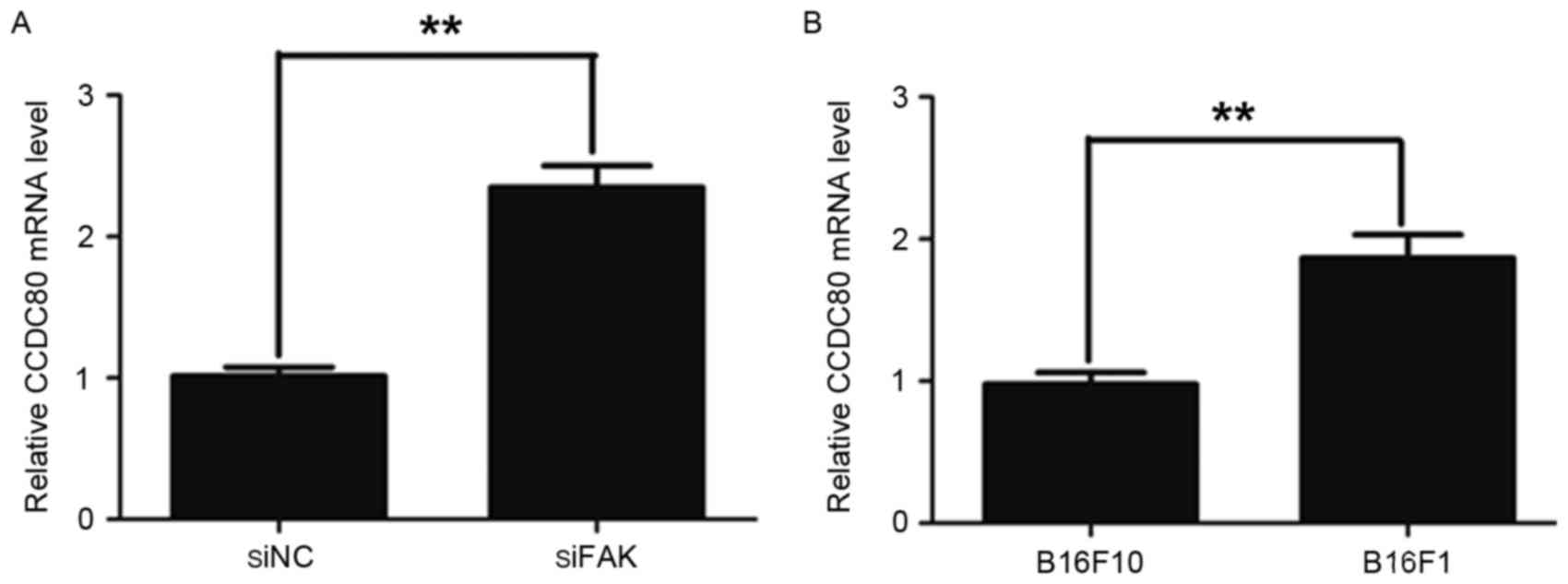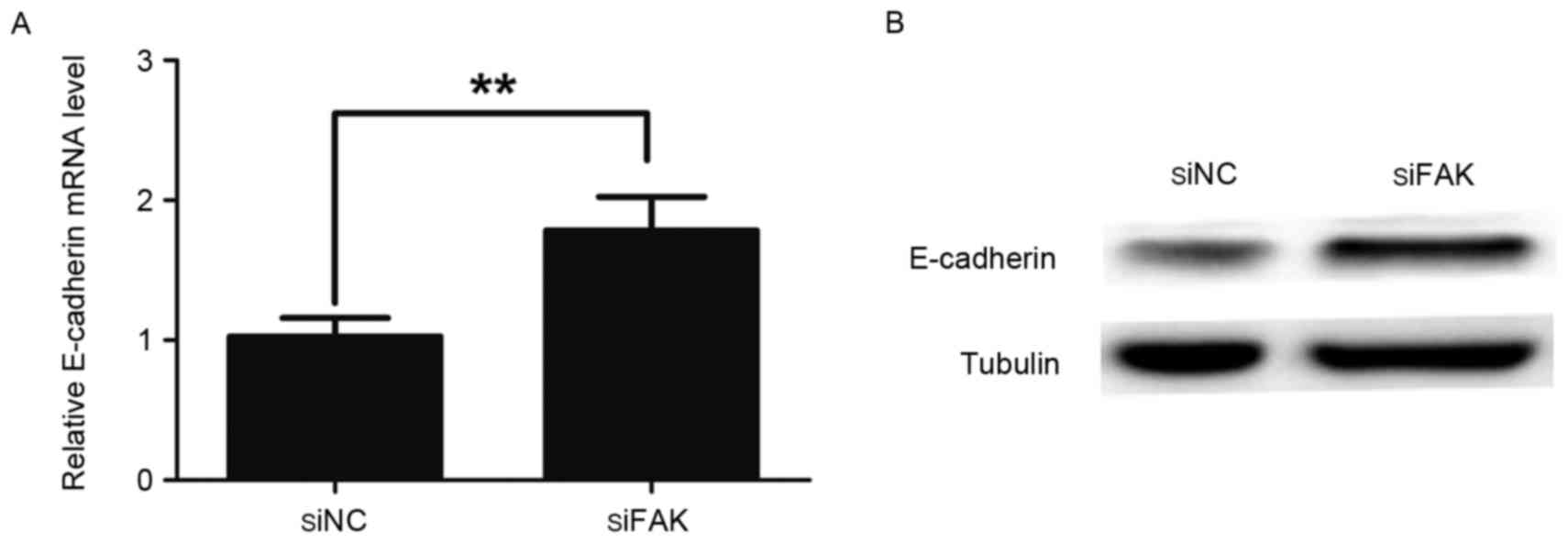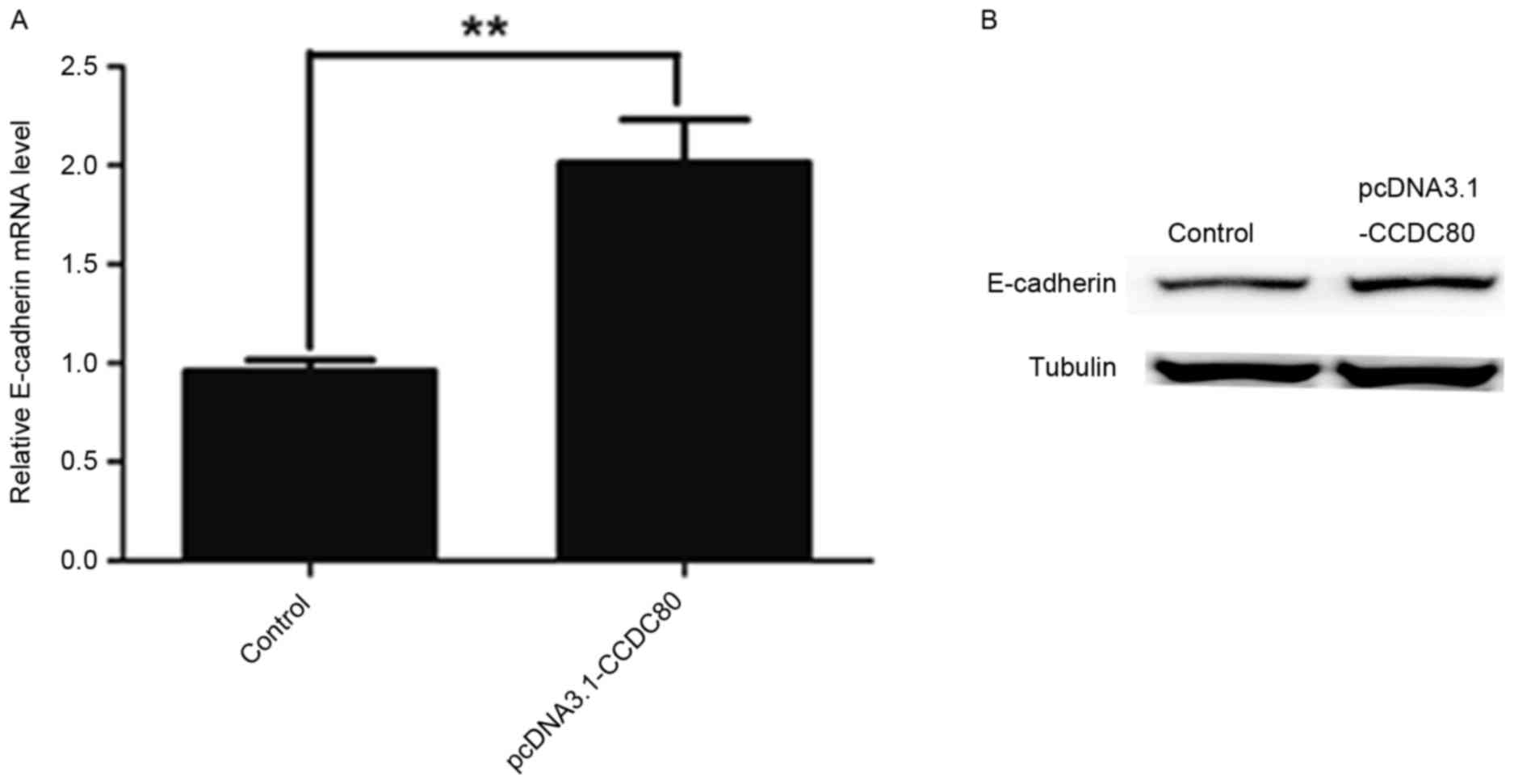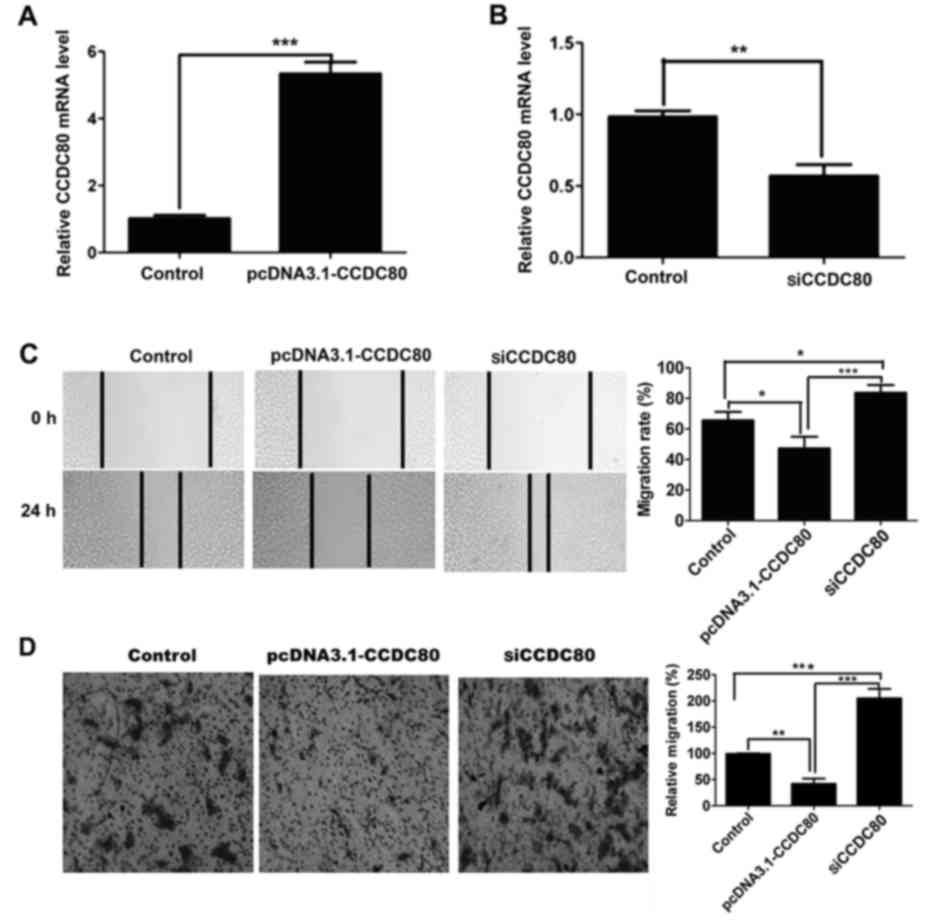The function of FAK/CCDC80/E‑cadherin pathway in the regulation of B16F10 cell migration
- Authors:
- Published online on: July 17, 2018 https://doi.org/10.3892/ol.2018.9159
- Pages: 4761-4767
Abstract
Introduction
Malignant melanoma is one of the most aggressive malignancies in humans, and is responsible for 60-80% of skin cancer-associated mortalities (1). As revealed in 2013, the 5-year survival rate of patients with metastatic malignant melanoma is ~14%, and its incidence has been increasing in the white population over the previous 2 decades (1). However, the mechanisms leading to the malignant transformation of melanocytes remains poorly understood. As a non-receptor tyrosine kinase, focal adhesion kinase (FAK) is widely expressed in various human tissues and cell types, including mesenchymal cells, neuronal cells, platelets, lymphocytes and erythrocytes (2,3). Overexpressed in a wide range of types of cancer (4), FAK promotes tumor cell migration and invasion (5). FAK is also involved in various signaling pathways that promote tumor growth and metastasis (6). However, the precise mechanisms underlying the regulatory role of FAK in cell migration remain to be elucidated.
Coiled-coil domain containing 80 (CCDC80) has been suggested to be a multifunctional protein among vertebrates (7). Previous studies have demonstrated that the expression of CCDC80 was downregulated in thyroid carcinomas, papillary carcinomas and colorectal and pancreatic cell lines (8–10). Ectopic expression of CCDC80 inhibits cancer cells growth in vitro, indicating that CCDC80 may be a candidate target for tumor therapy (10). In addition, CCDC80 also modulates the apoptotic pathways (10–12). However, the role of CCDC80 as a possible tumor suppressor remains unclear.
In the present study, the mechanism underlying the regulation of B16F10 cell migration by FAK was investigated. The knockdown of FAK promoted the expressions of CCDC80 and E-cadherin, and suppressed the migration of B16F10 cells. Meanwhile, CCDC80 was demonstrated to inhibit the migration of B16F10 cells, and elevate the level of E-cadherin. Clinical data for patients with melanoma from the Oncomine Cancer Microarray database were also analyzed and compared with the experimental data.
Materials and methods
Biological chemicals and antibodies
Blasticidin was obtained from Invitrogen; Thermo Fisher Scientific, Inc. (Waltham, MA, USA). The primary antibody against E-cadherin (cat. no.: 610181) was purchased from BD Biosciences (Franklin Lakes, NJ, USA), and the primary antibodies against extracellular-signal-regulated kinase (ERK; cat. no.: 4695S) and phosphorylated ERK (p-ERK; cat. no.: 4377S) were obtained from Cell Signaling Technology Inc. (Danvers, MA, USA). The primary antibody against tubulin (cat. no.: sc-32293) was obtained from Santa Cruz Biotechnology, Inc., (Dallas, TX, USA).
Cells and cell culture
Using small interfering (si)RNA, the stable interference of FAK in B16F10 cells [American Type Culture Collection (ATCC), Manassas, VA, USA] (siFAK) and siFAK negative control (siNC) cell lines were constructed by the State Key Laboratory of Pharmaceutical Biotechnology, School of Life Sciences, Nanjing University (Nanjing, Jiangsu). These cells, alongside B16F1 cells (ATCC), were cultured at 37°C and 5% CO2 in Dulbecco's modified Eagle's medium (DMEM; Wisent, Inc., St. Bruno, QC, Canada) supplemented with 10% fetal bovine serum (FBS; Life Technologies; Thermo Fisher Scientific, Inc.) and 3 mg/l−1 blasticidin.
Gene chip analysis
siFAK and siNC cells were lysed in 1 ml TRIzol® reagent (Life Technologies; Thermo Fisher Scientific, Inc.), and gene chip analysis was performed by CapitalBio Corporation (Beijing, China).
Migration assays
Cell migration was monitored by wound healing and transwell assays. For the wound healing assay, B16F10 cells that were transfected with pcDNA3.1-CCDC80 or pcDNA3.1 plasmid or siCCDC80 RNA were seeded at an initial density of 2×105 cells/well, and cultured (37°C, 5% CO2) in DMEM supplemented with 10% FBS overnight. Following culture (37°C, 5% CO2) of the cells in serum-free DMEM for an additional 24 h, a micro-pipette tip was used to create a wound in the monolayer of cells. Wound closures were observed by phase-contrast microscopy (magnification, ×40; Olympus Corporation, Tokyo, Japan), and digital images were captured at the interval times of 0 and 24 h (Photoshop CS6, Adobe Systems, Inc., San Jose, CA, USA). The percent migration rate was calculated using the formula: (1-T/C) ×100%, where T and C represent the scrape distance at the indicated treatment time (24 h) and at the previous treatment time (0 h), respectively.
For the transwell assay, 1×105 cells per insert (8-µm pore size) were incubated (37°C) in serum-free DMEM for 24 h in the upper chamber, with DMEM with 10% FBS in the lower chamber. Then, cells inside the inserts were removed with cotton swab, while cells on the underside of the inserts were fixed in 10% formalin for 20 min (room temperature) and stained at room temperature for 30 min (1% crystal violet). Cells from 5 random microscopic fields/insert were counted in triplicate at magnification, ×200.
Total RNA isolation and reverse transcription quantitative polymerase chain reaction (RT-qPCR)
Total RNA was extracted from siNC and siFAK cell lines using TRIzol® reagent (Life Technologies; Thermo Fisher Scientific, Inc.). RNA quantity (absorbance at wavelength 260 nm, A260) and purity (A260/A280) were determined by BioPhotometer® (Eppendorf, Hamburg, Germany). First-strand cDNA was synthesized with 1.5 µg of total RNA using a PrimeScript RT reagent kit (Takara Bio, Inc., Otsu, Japan). RT-qPCR was performed using FastStart Universal SYBR Green Master (Rox) (Roche Diagnostics, Basel, Switzerland). The thermocycler conditions were as follows: 95°C for 10 min, then 94°C for 10 sec and 60°C for 1 min, for 40 cycles. Data were normalized using GAPDH. The gene-specific primers were synthesized by Nanjing GenScript (Nanjing, China), and were as follows: CCDC80 forward, 5′-GATCCTGGAGCAGCCTCTGG-3′; CCDC80 reverse, 5′-ACATGGCTTCCAGCCTGACC-3′; nuclear receptor coactivator-3 (NCOA3) forward, 5′-TTCGCCTAGTCCACTCATCC-3′; NCOA3 reverse, 5′-GTGGACTCCGAGATCGGTAA-3; E-cadherin forward, 5′-GTGGGTCAGGAAATCACATC-3′; E-cadherin reverse, 5′-CTCCAAATCCGATACGTGATC-3′; GAPDH forward, 5′-TGAAGCAGGCATCTGAGGG-3′; GAPDH reverse, 5′-CGAAGGTGGAAGAGTGGGAG-3′.
RNA and plasmid transfection
CCDC80 (siCCDC80) and negative control (NC) siRNA were synthesized by Shanghai GenePharma Co., Ltd., (Shanghai, China). The PcDNA3.1-CCDC80 plasmid was donated by Professor Kolligs (University of Munich, Munich, Germany). Cells were transfected with the siRNA (100 pmol) or plasmid (1.5 µg) using Lipofectamine® 2000 (Invitrogen; Thermo Fisher Scientific, Inc.) according to the protocol of the manufacturer, and cultured for 48 h prior to harvesting and subsequent experimentation. The sequences of the siRNA were as follows: siCCDC80 forward, 5′-GAUGAGUAUGCAGGAUAUGUU-3′; siCCDC80 reverse, 5′-CAUAUCCUGCAUACUCAUCUU-3′; siNC forward, 5′-UUCUCCGAACGUGUCACGUTT-3′; siNC reverse, 5′-ACGUGACACGUUCGGAGAATT-3′. The 2−ΔΔCq method was used for quantification (13).
Western blot analysis
Cells were lysed in lysis buffer (Beyotime, Institute of Biotechnology, Haimen, China), and following staining with 0.1 g/l G-250 at room temperature for 1 min, protein determination was performed by measuring absorbance at a wavelength of 595 nm using the BioPhotometer® (Eppendorf, Hamburg, Germany). Total proteins (30 µg) were fractionated using SDS-PAGE (8%) and transferred onto nitrocellulose membranes. The membranes were blocked with 5% non-fat dried milk in 1× PBS Tween-20 buffer (5% tween-20) at room temperature for 1 h. and then incubated with the aforementioned primary antibodies (1:1,000) at room temperature for 1 h. Horseradish peroxidase-conjugated anti-mouse (cat. no.: 7076S; 1:2,000 dilution) or anti-rabbit IgG (cat. no.: 7074S; 1:2,000 dilution) from Cell Signaling Technology Inc. were used as the secondary antibodies at room temperature, and the protein bands were detected using an enhanced chemiluminesence detection system (Tanon Science and Technology Co., Ltd., Shanghai, China).
Analysis gene expression by Oncomine
The Oncomine Platform provides robust, peer-reviewed analysis methods that compute gene expression signatures, clusters and gene-set modules, extracting biological observations from the data. Following the successful registration of an Oncomine username, Oncomine (www.oncomine.org, last access date August 2016) was used to analyze the genes, terms searched were ‘CCDC80’, ‘FAK’ and ‘E-cadherin’.
Statistical analysis
The data are presented as the mean ± standard deviation. Analysis of two groups was performed using Student's t-test and comparisons of multiple groups was conducted using one-way analysis of variance with Tukey's post-hoc test. P<0.05 was considered to indicate a statistically significant difference. Software GraphPad Prism5 (GraphPad Software, Inc., La Jolla, CA, USA) was used for statistical analysis. A total of 3 replicates were performed for each experiment.
Results
Knockdown of FAK increases the expression levels of CCDC80 and E-cadherin in B16F10 cells
To explore the role of FAK in B16F10 melanoma progression, siFAK and siNC cell lines were constructed. It has been established previously that compared with those in the siNC cells, the mRNA and protein levels of FAK in siFAK cells were decreased markedly (14). In the present study, the gene chip assay revealed that the mRNA level of FAK was decreased, while the mRNA levels of CCDC80 and E-cadherin were increased in the siFAK cells compared with the siNC cells (Table I). The RT-qPCR assay also indicated that the CCDC80 mRNA level was significantly increased in the siFAK cells compared with that in the siNC cells (Fig. 1A). Previously, it was demonstrated that the expression level of FAK was lower in B16F1 cells, which exhibit low rates of metastasis, as compared with that in highly metastatic B16F10 cells (14). Therefore, the present study examined the CCDC80 mRNA level in B16F10 and B16F1 cells. It was identified that the CCDC80 mRNA level was increased in the B16F1 cells compared with that in the B16F10 cells (Fig. 1B). Concomitantly, RT-qPCR and western blotting assays also indicated that the expression of E-cadherin was significantly increased in the siFAK cells compared with the siNC cells (Fig. 2A and B). These data suggest that FAK inhibits the expression levels of CCDC80 and E-cadherin in B16F10 cells.
CCDC80 promotes the expression of E-cadherin
E-cadherin is a suppressor of tumor invasion and metastasis (15,16). Loss of E-cadherin expression promotes metastatic tumor dissemination and predicts poor prognosis (17). A previous study indicated that an increase in E-cadherin expression inhibited cancer cell migration (18). Additionally, CCDC80 was demonstrated to maintain a normal E-cadherin expression rate in thyroid cancer (8). As demonstrated in Figs. 1 and 2, knockdown of FAK promoted the expression levels of CCDC80 and E-cadherin in the B16F10 cells. However, it was not clear whether CCDC80 regulated E-cadherin expression in B16F10 cells. In the present study, it was identified that the overexpression of CCDC80 elevated E-cadherin expression in B16F10 cells at mRNA and protein levels (Fig. 3A and B). These data indicated that CCDC80 promoted E-cadherin expression in B16F10 cells.
CCDC80 inhibits B16F10 cell migration
As CCDC80 promoted E-cadherin expression, it may be involved in the regulation of B16F10 cell migration. To explore the role of CCDC80 in cell migration, the expression level of CCDC80 was upregulated or downregulated in B16F10 cells by transfection of pcDNA3.1-CCDC80 plasmids or siCCDC80 molecules, respectively (Fig. 4A and B). The results from the wound healing assay indicated that the upregulation of CCDC80 inhibited B16F10 cell migration, while the downregulation of CCDC80 promoted B16F10 cell migration compared with the control (Fig. 4C). The transwell assay also suggested that the upregulation of CCDC80 inhibited B16F10 cell migration compared with the control (Fig. 4D). Taken together, these results demonstrated that CCDC80 may inhibit B16F10 cell migration.
mRNA levels of FAK, CCDC80 and E-cadherin in patients with melanoma
As aforementioned, it was identified that FAK regulates E-cadherin expression via CCDC80, and CCDC80 may regulate B16F10 cell migration. Consequently, the mRNA levels of FAK, CCDC80 and E-cadherin in human melanoma were analyzed using the Oncomine Cancer Microarray database (www.oncomine.org). As revealed by melanoma datasets from Riker et al and Haqq et al (data from www.oncomine.org), the expression level of FAK was upregulated, while the expression levels of CCDC80 and E-cadherin were downregulated in human melanoma samples compared with the normal controls (Tables II and III). In the Critchley-Thorne melanoma dataset (data from www.oncomine.org), the mRNA level of FAK was decreased, while the mRNA levels of CCDC80 and E-cadherin were upregulated (Table IV). The results from human melanoma datasets are consistent with the data from the siFAK cells, suggesting that the regulation of B16F10 melanoma cell migration by FAK is potentially mediated by CCDC80 (Fig. 5).
Discussion
Malignant melanoma is one of the most aggressive types of malignancy (19–21), and the incidence of melanoma is increasing more rapidly compared with any other type of cancer globally (22). In the present study it was demonstrated that FAK is overexpressed and may serve a key role in melanoma progression, the role of FAK in B16F10 cell migration was investigated and the underlying mechanism was additionally explored. It was identified that the knockdown of FAK promoted the expression levels of CCDC80 and E-cadherin, and suppressed the migration of B16F10 cells. Concurrently, CCDC80 inhibited the migration of B16F10 cells, and increased the levels of E-cadherin. In the present study, only the role of CCDC80 in B16F10 cell migration was examined. As a potential target for tumor therapy, the roles of CCDC80 in cell proliferation and apoptosis require additional investigation.
However, it remains to be elucidated how FAK regulates CCDC80 and E-cadherin in B16F10 cells. As demonstrated in Fig. 1A, the RT-qPCR assay indicated that the CCDC80 mRNA level was significantly increased in siFAK cells, suggesting that FAK regulates CCDC80 expression at the transcriptional level. It has been revealed that NCOA3 is overexpressed in primary cutaneous melanoma, and that NCOA3 is a negative regulator of CCDC80 (23). When the expression of NCOA3 was silenced in MCF-7 cells, there was a significant increase in the expression level of CCDC80 (12). Additionally, it was suggested that ERK may modulate NCOA3 (24). An increased phosphorylation of ERK was accompanied by an increased expression of NCOA3 in MCF7-YB-1 cells (25). Preliminary data indicated that the protein level of p-ERK was decreased in siFAK cells (data not shown). In addition, the results from the gene chip assay (Table V) and RT-qPCR assay (data not shown) revealed that the mRNA level of NCOA3 was downregulated in siFAK cells. The data suggest that FAK may regulate CCDC80 via the ERK/NCOA3 signaling pathway.
There are also certain indications of how CCDC80 regulates E-cadherin expression. As revealed in Fig. 3A, the overexpression of CCDC80 increased the mRNA level of E-cadherin, indicating that CCDC80 regulates E-cadherin expression at the transcriptional level. A previous study demonstrated that the silencing of CCDC80 decreases the mRNA level of peroxisome proliferator-activated receptor γ (PPARγ), suggesting that PPARγ is a downstream target of CCDC80 (14). Preliminary data from the present study indicated that FAK knockdown promoted PPARγ expression, and that PPARγ knockdown decreased E-cadherin expression (data not shown). Therefore, it was hypothesized that CCDC80 promotes E-cadherin expression via PPARγ. However, additional studies are required to provide complete characterization of this interaction.
In conclusion, the data of the present study suggest that FAK potentially regulates B16F10 cell migration by the CCDC80/E-cadherin pathway. These results may assist in melanoma treatment by the identification of a novel biomarker for diagnosis.
Acknowledgements
The authors would like to thank Mrs. Min Lu and Mr Tongyang Zhu (The State Key Laboratory of Pharmaceutical Biotechnology, School of Life Sciences, Nanjing University, Nanjing, China) for their assistance with experimental apparatus and materials.
Funding
The present study was supported by grants from the National Natural Science Foundation of China (grant nos.: 81421091, 30425009, 30330530, 31200572, 81121062 and 31071196), the Natural Science Foundation of Jiangsu province (grant no.: BE2013630) and Bureau of Science and Technology of Changzhou (grant no.: CE20135013).
Availability of data and materials
The datasets used and/or analyzed during the present study are available from the corresponding author on reasonable request.
Authors' contributions
ZCH undertook study design; GP and YL were responsible for study design and conducting the experiments. WL designed the primers, GP wrote the manuscript and LJ contributed substantially to the analysis and interpretation of data for the work and revised the manuscript.
Ethics approval and consent to participate
Not applicable.
Patient consent for publication
Not applicable.
Competing interests
The authors declare that they have no competing interests.
Glossary
Abbreviations
Abbreviations:
|
FAK |
focal adhesion kinase |
|
CCDC80 |
coiled-coil domain containing 80 |
|
NC |
normal control |
|
NCOA3 |
nuclear receptor coactivator-3 |
|
RT-qPCR |
quantitative real time polymerase chain reaction |
|
siFAK cell line |
stable interference of FAK in B16F10 cells |
|
siNC cell line |
negative control for siFAK cell line |
References
|
Bandarchi B, Jabbari CA, Vedadi A and Navab R: Molecular biology of normal melanocytes and melanoma cells. J Clin Pathol. 66:644–648. 2013. View Article : Google Scholar : PubMed/NCBI | |
|
Cary LA and Guan JL: Focal adhesion kinase in integrin-mediated signaling. Front Biosci. 4:D102–D113. 1999. View Article : Google Scholar : PubMed/NCBI | |
|
Schlaepfer DD, Hauck CR and Sieg DJ: Signaling through focal adhesion kinase. Prog Biophys Mol Biol. 71:435–478. 1999. View Article : Google Scholar : PubMed/NCBI | |
|
Lee BY, Timpson P, Horvath LG and Daly RJ: FAK signaling in human cancer as a target for therapeutics. Pharmacol Ther. 146:132–149. 2015. View Article : Google Scholar : PubMed/NCBI | |
|
McLean GW, Carragher NO, Avizienyte E, Evans J, Brunton VG and Frame MC: The role of focal-adhesion kinase in cancer-a new therapeutic opportunity. Nat Rev Cancer. 5:505–515. 2005. View Article : Google Scholar : PubMed/NCBI | |
|
Sulzmaier FJ, Jean C and Schlaepfer DD: FAK in cancer: Mechanistic findings and clinical applications. Nat Rev Cancer. 14:598–610. 2014. View Article : Google Scholar : PubMed/NCBI | |
|
Brusegan C, Pistocchi A, Frassine A, Della Noce I, Schepis F and Cotelli F: Ccdc80-l1 Is involved in axon pathfinding of zebrafish motoneurons. PLoS One. 7:e318512012. View Article : Google Scholar : PubMed/NCBI | |
|
Ferraro A, Schepis F, Leone V, Federico A, Borbone E, Pallante P, Berlingieri MT, Chiappetta G, Monaco M, Palmieri D, et al: Tumor suppressor role of the CL2/DRO1/CCDC80 gene in thyroid carcinogenesis. J Clin Endocrinol Metab. 98:2834–2843. 2013. View Article : Google Scholar : PubMed/NCBI | |
|
Visconti R, Schepis F, Iuliano R, Pierantoni GM, Zhang L, Carlomagno F, Battaglia C, Martelli ML, Trapasso F, Santoro M and Fusco A: Cloning and molecular characterization of a novel gene strongly induced by the adenovirus E1A gene in rat thyroid cells. Oncogene. 22:1087–1097. 2003. View Article : Google Scholar : PubMed/NCBI | |
|
Bommer GT, Jäger C, Dürr EM, Baehs S, Eichhorst ST, Brabletz T, Hu G, Fröhlich T, Arnold G and Kress DC: DRO1, a gene down-regulated by oncogenes, mediates growth inhibition in colon and pancreatic cancer cells. J Biol Chem. 280:7962–7975. 2005. View Article : Google Scholar : PubMed/NCBI | |
|
Herbst A, Bayer C, Wypior C and Kolligs FT: DRO1 sensitizes colorectal cancer cells to receptor-mediated apoptosis. Oncol Lett. 2:981–984. 2011.PubMed/NCBI | |
|
Ferragud J, Avivar-Valderas A, Pla A, De Las Rivas J and Font de Mora J: Transcriptional repression of the tumor suppressor DRO1 by AIB1. FEBS Lett. 585:3041–3046. 2011. View Article : Google Scholar : PubMed/NCBI | |
|
Livak KJ and Schmittgen TD: Analysis of relative gene expression data using real-time quantitative PCR and the 2(−Delta Delta C(T)) method. Methods. 25:402–408. 2001. View Article : Google Scholar : PubMed/NCBI | |
|
Lan Y and Hua ZC: Construction of stable focal adhesion kinase knockdown cell line and preliminary study of its properties. Yao Xue Xue Bao. 47:1128–1133. 2012.(In Chinese). PubMed/NCBI | |
|
Singhai R, Patil VW, Jaiswal SR, Patil SD, Tayade MB and Patil AV: E-Cadherin as a diagnostic biomarker in breast cancer. N Am J Med Sci. 3:227–233. 2011. View Article : Google Scholar : PubMed/NCBI | |
|
Khan P, Manna A, Saha S, Mohanty S, Mukherjee S, Mazumdar M, Guha D and Das T: Aspirin inhibits epithelial-to-mesenchymal transition and migration of oncogenic K-ras-expressing non-small cell lung carcinoma cells by down-regulating E-cadherin repressor Slug. BMC Cancer. 16:392016. View Article : Google Scholar : PubMed/NCBI | |
|
Venza M, Visalli M, Catalano T, Biondo C, Beninati C, Teti D and Venza I: DNA methylation-induced E-cadherin silencing is correlated with the clinicopathological features of melanoma. Oncol Rep. 35:2451–2460. 2016. View Article : Google Scholar : PubMed/NCBI | |
|
Cui T, Srivastava AK, Han C, Yang L, Zhao R, Zou N, Qu M, Duan W, Zhang X and Wang QE: XPC inhibits NSCLC cell proliferation and migration by enhancing E-Cadherin expression. Oncotarget. 6:10060–10072. 2015. View Article : Google Scholar : PubMed/NCBI | |
|
Russo AE, Torrisi E, Bevelacqua Y, Perrotta R, Libra M, McCubrey JA, Spandidos DA, Stivala F and Malaponte G: Melanoma: Molecular pathogenesis and emerging target therapies (Review). Int J Oncol. 34:1481–1489. 2009.PubMed/NCBI | |
|
Shoo BA and Kashani-Sabet M: Melanoma arising in African-, Asian-, Latino- and Native-American populations. Semin Cutan Med Surg. 28:96–102. 2009. View Article : Google Scholar : PubMed/NCBI | |
|
Jemal A, Bray F, Center MM, Ferlay J, Ward E and Forman D: Global cancer statistics. CA Cancer J Clin. 61:69–90. 2011. View Article : Google Scholar : PubMed/NCBI | |
|
Rigel DS and Carucci JA: Malignant melanoma: Prevention, early detection, and treatment in the 21st century. CA Cancer J Clin. 50:215–240. 2000. View Article : Google Scholar : PubMed/NCBI | |
|
Rangel J, Torabian S, Shaikh L, Nosrati M, Baehner FL, Haqq C, Leong SP, Miller JR III, Sagebiel RW and Kashani-Sabet M: Prognostic significance of nuclear receptor coactivator-3 overexpression in primary cutaneous melanoma. J Clin Oncol. 24:4565–4569. 2006. View Article : Google Scholar : PubMed/NCBI | |
|
Font de Mora J and Brown M: AIB1 is a conduit for kinase-mediated growth factor signaling to the estrogen receptor. Mol Cell Biol. 20:5041–5047. 2000. View Article : Google Scholar : PubMed/NCBI | |
|
Ito T, Kamijo S, Izumi H, Kohno K, Amano J and Ito K: Alteration of Y-box binding protein-1 expression modifies the response to endocrine therapy in estrogen receptor-positive breast cancer. Breast Cancer Res Treat. 133:145–159. 2012. View Article : Google Scholar : PubMed/NCBI |














